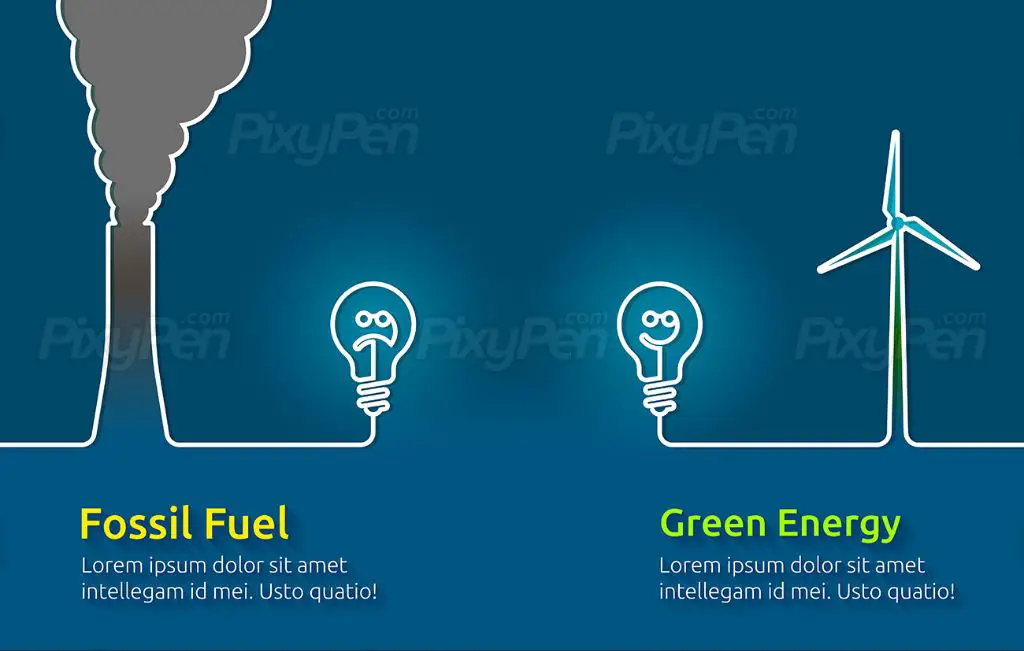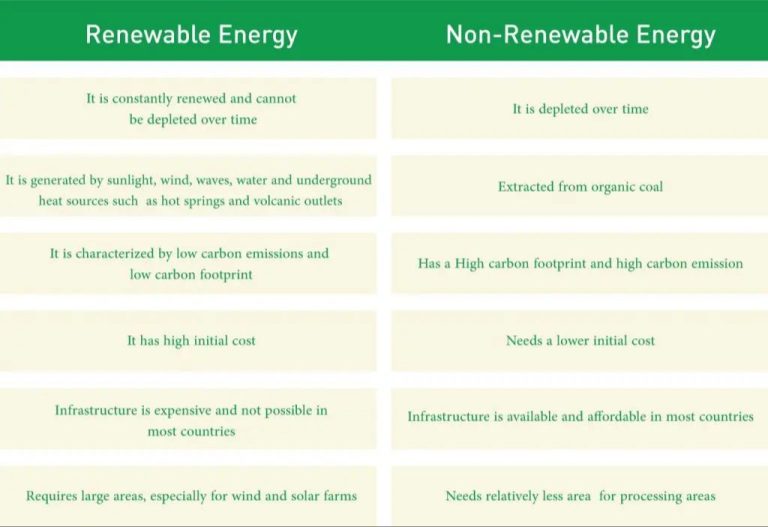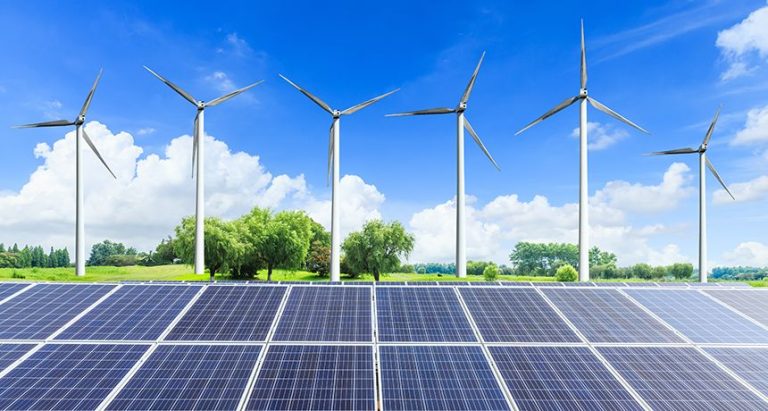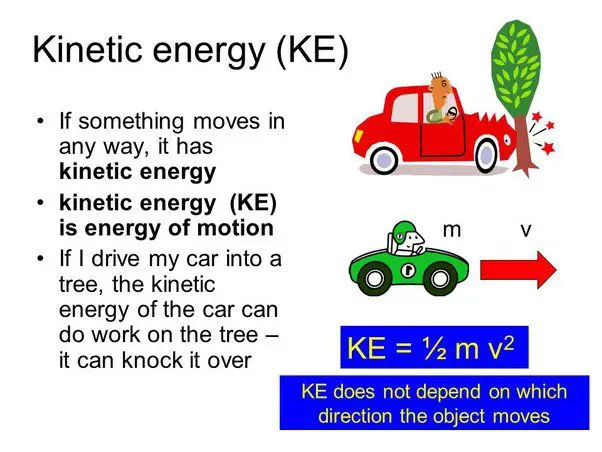Is Renewable Energy Better Than Fossil Fuels?

The debate between renewable energy and fossil fuels is central to discussions about the future of energy production and use. With concerns about climate change and energy security growing, many advocate transitioning from fossil fuels like coal, oil and natural gas to renewable sources like solar, wind and hydropower.
Renewable energy is generally better for the environment than fossil fuels, but fossil fuels currently meet more of our energy needs. We’ll examine the pros and cons of both energy sources in this article.
Renewable energy comes from naturally replenishing sources like sunlight, wind, water and geothermal heat. Technologies harness these sources to generate electric power. Examples include solar panels, wind turbines, hydroelectric dams and geothermal plants.
Fossil fuels are non-renewable energy sources formed over billions of years from decayed plants and animals. Oil, natural gas and coal are examples. They are burned to produce electricity, heat buildings and power vehicles.
While renewable sources are growing fast, fossil fuels supplied over 80% of US energy needs in 2019 according to the EIA. But costs for renewables are falling, and many experts expect their share to rise in the coming decades.
Types of Renewable Energy
There are several major types of renewable energy sources that are in use today:
Solar Energy – Solar power is harnessed from the sun’s radiation and converted into electricity using solar panels. Solar energy can be used for electricity generation, heating/cooling homes, solar hot water, and a variety of commercial and industrial uses. (1)
Wind Energy – Wind turbines convert the kinetic energy of wind into mechanical power which is then converted into electricity. Wind power is increasingly being used around the world for electricity generation and water pumping. (2)
Hydroelectric Power – Hydropower harnesses the energy of flowing or falling water to generate electricity. Hydroelectric dams control water flow and use turbines to convert the kinetic energy of the moving water into mechanical energy and then electricity. (1)
Geothermal Energy – Geothermal power utilizes the internal heat of the Earth’s crust to drive steam turbines that generate electricity. Geothermal energy can also be used directly for heating and cooling buildings. (2)
Biomass Energy – Biomass refers to organic matter such as wood, agricultural waste, or animal waste that can be burned to produce heat and generate electricity. Biomass can also be converted to transportation fuels like ethanol and biodiesel. (1)
(1) https://www.un.org/en/climatechange/what-is-renewable-energy
(2) https://www.nationalgrid.com/stories/energy-explained/what-are-different-types-renewable-energy
Pros of Renewable Energy
Renewable energy sources provide substantial environmental and economic benefits compared to fossil fuels. Some of the main advantages of renewable energy include:
Cleaner energy production – Renewables like solar, wind, and hydropower produce little to no global warming emissions or air pollutants (1). In contrast, burning fossil fuels emits greenhouse gases like carbon dioxide that contribute significantly to climate change and air pollution.
Reduces greenhouse gases – The renewable energy sector has grown rapidly in recent years. As a result, renewable energy accounted for 12.2% of total U.S. energy consumption and 20% of electricity generation in 2019. Increased use of renewable energy has avoided the emission of more than 1.5 billion metric tons of carbon dioxide per year when compared to an all fossil fuel scenario (2).
Infinite supply – Renewable energy sources like sunlight, wind, and geothermal heat are constantly replenished and will never run out. This provides energy security and reduces dependence on finite fossil fuel reserves that fluctuate in price and availability.
Decentralized electricity production – Renewable energy systems allow electricity to be generated from multiple small-scale systems across the grid, unlike centralized fossil fuel power plants. This provides more resilient and reliable electricity supply.
(1) https://www.ucsusa.org/resources/benefits-renewable-energy-use
(2) https://www.epa.gov/statelocalenergy/local-renewable-energy-benefits-and-resources
Cons of Renewable Energy
While renewable energy has many benefits, it also has some drawbacks compared to traditional fossil fuels. One major con is the higher upfront costs associated with building new renewable energy infrastructure. According to the EnergySage, “The main drawback of renewable energy is the upfront cost of building the infrastructure, followed by the cost of maintaining it.”
For example, building a large-scale wind or solar farm can cost millions of dollars in initial investments. Fossil fuel power plants in comparison have more established infrastructure already in place.
Another disadvantage of renewables is their intermittency and the need for energy storage. As the GreenMatch explains, “Renewable energy sources are natural forces that are strongly dependent on the weather conditions. Therefore, renewable energy is intermittent.”
The sun doesn’t always shine and the wind doesn’t always blow when electricity is needed most. This requires developing energy storage solutions like batteries to smooth out renewable power delivery. Scaling up storage is complex and adds costs.
Additionally, renewable energy projects like bioenergy or hydropower can conflict with land use. As the UCSUSA points out, “Suitable land for renewables is limited and various stakeholders contest the use of public lands for energy production.” Renewables may compete for land with agriculture, recreation, or conservation priorities.
Types of Fossil Fuels
The three main types of fossil fuels are petroleum, coal, and natural gas. Petroleum, also known as crude oil, is a liquid fossil fuel that is found beneath the Earth’s surface and extracted through drilling. According to the U.S. Energy Information Administration, petroleum accounts for about 40% of the energy consumption in the United States. Some of the products derived from petroleum include gasoline, diesel fuel, heating oil, and many ingredients for chemicals, plastics, and pharmaceuticals (https://www.eia.gov/energyexplained/oil-and-petroleum-products/use-of-oil.php).
Coal is a solid fossil fuel that is usually brown or black in color. It is extracted through mining operations and is made up of carbon, oxygen, hydrogen, nitrogen, and varying amounts of sulfur and other elements. Coal is primarily used for generating electricity and providing heat. According to the U.S. Energy Information Administration, coal accounts for about 20% of energy consumption in the United States (https://www.eia.gov/energyexplained/coal/).
Natural gas is a fossil fuel in gas form that is colorless and odorless in its pure form. It is composed mainly of methane, but can contain varying amounts of other hydrocarbons. Natural gas is extracted through traditional and hydraulic fracturing drilling methods. It generates about 32% of electricity in the United States and also has residential, commercial, and industrial applications like heating, cooking, and powering appliances (https://www.eia.gov/energyexplained/natural-gas/).
Pros of Fossil Fuels
Fossil fuels have several major advantages that have made them the dominant global energy source for over a century. Some of the key pros of fossil fuels include:
Fossil fuels are energy dense and reliable energy sources. As noted by Kiwi Energy, fossil fuels can produce large amounts of energy efficiently and reliably. Power plants that run on fossil fuels like coal and natural gas can operate 24/7 and provide stable baseload power.
Fossil fuels take advantage of established infrastructure for production, transportation and consumption, as pointed out by UNC Pembroke. Extensive supply chains, pipelines, power plants, and other infrastructure already exist to support the fossil fuel industry.
As noted by Lehigh University, fossil fuels like coal and natural gas are cost-effective energy sources. The infrastructure and processes for extracting, refining and using fossil fuels are well-established and benefit from economies of scale.
Cons of Fossil Fuels
Fossil fuels have several significant drawbacks that need to be considered:
Major source of air pollution – Burning of fossil fuels produces large amounts of carbon dioxide, sulfur dioxide, nitrogen oxides, particulate matter, and other pollutants that contribute to smog, acid rain, respiratory illness, and climate change (Fossil Fuels: The Dirty Facts).
Finite supply – Fossil fuels are non-renewable energy sources formed over millions of years. At current consumption rates, oil, coal, and natural gas reserves are projected to run out within several decades (Pros and cons of fossil fuels & why can fossil fuels be good?).
Price volatility – As finite resources, fossil fuel prices fluctuate greatly depending on discovery of new reserves and global supply and demand. Price shocks can destabilize economies (Disadvantages of Fossil Fuels & Oil).
Environmental damage from extraction – Oil spills, fracking, mountaintop removal, and other fossil fuel extraction processes can pollute waterways, destroy habitats, and harm local communities.
Current Status and Trajectory
Currently, fossil fuels like oil, coal, and natural gas supply about 80% of the world’s energy needs, according to the International Energy Association (IEA). However, renewable energy sources like solar, wind, hydropower and bioenergy are the fastest-growing energy sources worldwide. From 2010 to 2020, renewable energy use grew at an average annual rate of over 5%, while fossil fuel use grew by only 1% per year, according to the Center for Climate and Energy Solutions (C2ES).
Several projections show renewables continuing their rapid growth in the coming decades. According to Statista forecasts, global renewable energy capacity is expected to grow at an annual rate of nearly 4% from 2024 to 2028 (Statista). The International Energy Agency predicts renewable energy will supply over 40% of global electricity by 2028, with solar and wind doubling their share to 25% (IEA). If current trends continue, renewables are poised to become a major part of the global energy mix within the next few decades.
Policy Solutions
There are various policy solutions that can help accelerate the transition from fossil fuels to renewable energy. Three of the most impactful policies are:
Carbon pricing puts a price on carbon emissions, making fossil fuels more expensive and encouraging the shift to clean energy. Examples include carbon taxes and cap-and-trade systems. Research shows carbon pricing can reduce emissions cost-effectively while supporting economic growth.https://energyinnovation.org/wp-content/uploads/2015/11/EnergyInnovation-PolicySolutions.pdf
Clean energy subsidies and mandates like renewable portfolio standards help drive growth in wind, solar, and other renewables. These policies create demand, lower costs through economies of scale, and accelerate the transition. For example, state renewables mandates have been a major driver of growth in U.S. wind and solar capacity.https://rmi.org/energy-policy-simulator/
Investing in grid flexibility and management makes it easier to integrate variable renewables onto the electric grid. Upgrading transmission lines, energy storage, and demand response programs are key grid flexibility solutions identified by research.https://energypolicy.solutions/
Conclusion
The research makes it clear that renewable energy sources like solar, wind, geothermal and hydropower are cleaner and more sustainable than fossil fuels. Renewables produce little to no greenhouse gas emissions, reduce air pollution, and help mitigate climate change. However, the transition from fossil fuels will take time given the massive infrastructure built around oil, coal and natural gas. Renewables currently only provide about 11% of total global energy demand. While costs have dropped dramatically, they still remain more expensive per kWh than fossil fuels in most cases. Intermittent power generation from sources like solar and wind also create grid reliability challenges. Policy solutions like carbon pricing, clean energy mandates and subsidies can accelerate the transition, but require political will. Balanced policies that support both renewables and ensure grid stability as fossil fuels are phased out will enable a smooth transition to a low carbon economy powered by clean energy.[1]







